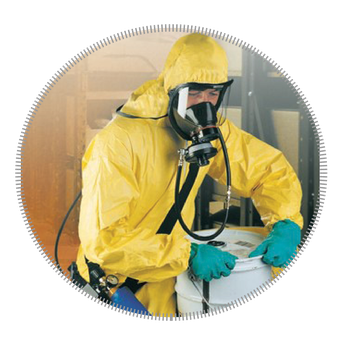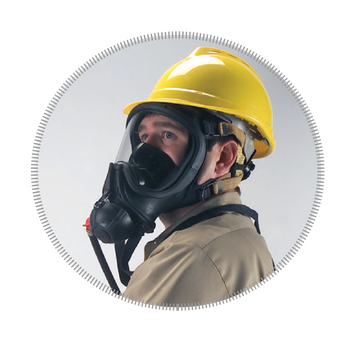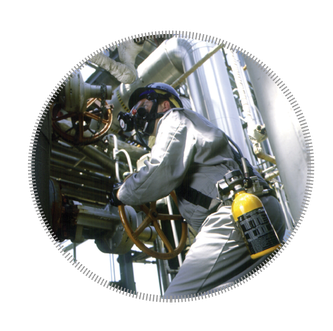


Respirator Selection for Oxygen-deficient Atmospheres
Answering Critical Questions about ANSI/ASSE Z88.2-2015
BY DAVID L. SPELCE, RICHARD W. METZLER, JAMES S. JOHNSON, AND TIMOTHY R. REHAK
Respirator program administrators and respirator users should be aware that every year, numerous employees are seriously injured or die in diverse workplaces due to oxygen deficiency. Oxygen-deficient locations are often unpleasant places such as sewers, sewage pump stations, and manure pits. But even pleasant-sounding worksites, such as vessels for producing molasses used on pancakes, can have deadly oxygen-deficient atmospheres.
The topic of oxygen deficiency comprises complex scientific principles associated with chemistry, human physiology, and engineering. However, selecting respirators for use in oxygen-deficient atmospheres is not complicated when informed by a proper exposure assessment of the workplace and its atmosphere, and by knowledge of occupational exposure limits (OELs) and guidelines from OSHA and NIOSH.
This short article is not intended as a comprehensive discussion of oxygen deficiency or its assessment. It was written to answer critical questions on respirator selection for protection against oxygen-deficient atmospheres, as addressed in the new ANSI/ASSE Z88.2-2015 standard, Practices for Respiratory Protection. We hope the article lessens some of the mystery of this essential element of respirator selection.
CRITICAL QUESTIONS
Most people have been taught to think about the amount of oxygen present in the earth’s atmosphere as a percentage. Almost all high school students know that the atmospheric concentration of oxygen is approximately 21 percent. So why do regulations complicate matters with partial pressures of oxygen?
We intuitively know that there is less oxygen at high altitudes. Most laypeople likely believe that the percentage of oxygen is lower at higher altitudes. This is not the case: air constituents are present in the same proportions throughout the atmosphere, and their percentages remain the same. In normal conditions, oxygen comprises 21 percent of the earth’s atmosphere from sea level to the highest mountaintop.
As altitude increases, the partial pressures of all atmospheric components, including oxygen, decrease. At high altitudes, atmospheric pressure is lower, causing air molecules to spread out farther than they do at sea level.
“Partial pressure,” measured in millimeters of mercury (mmHg), refers to the pressure a particular gas exerts in a mixture of gases. On top of the highest mountain, since there are fewer air molecules, the partial pressure of oxygen (PO2) is lower than at sea level—but oxygen still comprises 21 percent of the air. At sea level, the PO2 is 159 mmHg. At an altitude of 14,000 feet, the PO2 is only 94 mmHg.
As explained in Annex A.3 of Z88.2-2015, the partial pressure of oxygen—not the percentage of O2 or the atmospheric pressure—is of utmost importance in respiration. Unacclimatized people working in atmospheres with reduced PO2 experience more fatigue than they do when performing the same work at sea level. Working at higher altitudes, their breathing rate and heart rate are higher, and they experience symptoms of fatigue more quickly than they would at lower altitudes with the same workload.
On the other hand, people who live and work at high altitudes do so with little or no physiological effect because they become acclimatized. According to Annex A.3 of Z88.2-2015,
[t]he human body can adapt to the reduced PO2 levels by making compensating changes to its respiratory, cardiovascular and hematopoietic systems. Complete acclimatization requires about four weeks' residence at the ambient PO2. Acclimatized individuals entering a confined space at high altitude should not be required to wear SCBA for protection against oxygen deficiency, if the partial pressure of oxygen inside the confined space is the same as the PO2 outside the confined space.
It is vitally important for respirator program administrators to consider PO2 in situations where the normal atmospheric oxygen concentration (21 percent) is lowered by industrial causes, such as inerting a chemical reaction vessel with nitrogen; or by natural causes, such as oxidation of steel or iron within a compartment. Both processes displace the oxygen inside the vessel or compartment. When these processes occur above sea level, where the partial pressure of oxygen is already lower, they can combine with the effects of altitude to create an oxygen-deficient environment. Therefore, the PO2 must be taken into consideration during hazard analysis. That is why Z88.2-2015 uses both percent oxygen and oxygen partial pressure in establishing oxygen OELs. Hazard assessment results are, of course, compared to oxygen OELs. This comparison is the primary basis for selecting the type of respirator necessary to protect workers against the level of oxygen deficiency determined during hazard assessment of the worksite atmosphere.
Figure 1. Oxygen-Deficient Conditions and Probable Effects
Table A.3-1 of Z88.2-2015, reproduced in Figure 1, illustrates the increasingly adverse effects on humans as the atmosphere becomes increasingly oxygen-deficient.
Question 2: What is an oxygen-deficient atmosphere?
Z88.2-2015 defines oxygen-deficient atmospheres as containing oxygen concentrations below 19.5 percent oxygen at sea level or an atmospheric PO2 <148 mmHg. As mentioned previously, oxygen-deficient atmospheres can result from industrial and natural processes that displace oxygen, or from an increase in altitude. At an altitude of 2,000 feet, the PO2 falls below 148 mmHg.
Question 3: Can air-purifying respirators be worn in oxygen-deficient atmospheres?
For atmospheres with an oxygen concentration between 20.9 and 19.5 percent oxygen at sea level (PO2 between 159 and 148 mmHg), Z88.2-2015 allows the use of air-purifying respirators. However, for atmospheres with less than 19.5 percent oxygen at sea level (PO2 <148 mmHg), use of air-purifying respirators is prohibited (Section 7.2.4).
For PO2 between 159 and 148 mmHg, air-purifying respirators may be worn if the source of the oxygen reduction is understood and controlled, and the other inhalation hazards and their concentrations are such that the protection provided by air-purifying respirators is adequate. Although not directly addressed in Z88.2-2015, acclimatized people should not be prevented from wearing air-purifying respirators in ambient atmospheric conditions at the altitudes in which they are used to living and working, at altitudes up to 14,000 feet, as long as the ambient oxygen content remains above 19.5 percent and the wearer has no medical condition that would require the use of supplemental oxygen. This is permissible for the same reasons that Z88.2-2015 does not require acclimatized individuals to wear SCBA for entering a confined space if the PO2 inside the confined space is the same as the PO2 outside the confined space.
Question 4: What is an immediately dangerous to life or health (IDLH) oxygen-deficient atmosphere?
IDLH is any atmosphere that poses an immediate hazard to life or immediate irreversible debilitating effects on health. Section 7.1.1.4.1 of Z88.2-2015 explains that atmospheres with less than 16 percent oxygen at sea level (PO2 <122 mmHg) are considered O2-deficient IDLH. According to the OSHA Respirator Standard preamble, NIOSH produced evidence to OSHA showing that in an atmosphere with oxygen concentration of less than 16 percent at sea level, employees may experience impaired attention, thinking, and coordination.
Also, atmospheres in locations (including confined spaces) for which the oxygen concentration is unknown are considered to be IDLH oxygen-deficient atmospheres. For any locations where the oxygen concentration is unable to be known, for whatever reason, they must be considered IDLH. People still die each year from entering spaces for which the oxygen concentration is unknown.
Question 5: What is a non-IDLH oxygen-deficient atmosphere?
Section 7.1.1.4.2 explains that locations with O2-deficient, non-IDLH atmospheres have oxygen concentrations between 16 and <19.5 percent oxygen at sea level (PO2 between ≥122 mmHg and PO2 <148 mmHg).
Abbreviated Decision Logic on Respirator Selection for Oxygen-deficient Atmospheres for Unacclimatized
Individuals
This table is an overly simplistic key to illustrate Z88.2-2015 respirator selection for oxygen-deficient atmospheres once hazard assessment is performed. Actual respirator selection must be performed with an understanding of all the O2 deficiency-related topics explained in the standard.
Notes:
1. Atmosphere-supplying respirators are allowed to be worn only if the source of the oxygen reduction is understood and controlled. 2. Oxygen reduction must be understood and controlled, and the type of other inhalation hazards and their concentrations are such that the protection provided by air-purifying respirators is adequate.
1. Atmosphere-supplying respirators are allowed to be worn only if the source of the oxygen reduction is understood and controlled. 2. Oxygen reduction must be understood and controlled, and the type of other inhalation hazards and their concentrations are such that the protection provided by air-purifying respirators is adequate.
Tap on the graphic below to open a larger version in your browser.
Question 6: What respirators can be worn in IDLH oxygen-deficient atmospheres?
Z88.2-2015 respirator selection for O2-deficient IDLH atmospheres requires the most stringent protective respirators available on the market for protection against the deadly danger of hypoxia (that is, when tissues of the body are inadequately oxygenated). Respirator selection for O2-deficient IDLH atmospheres is either full-face pressure-demand self-contained breathing apparatus (SCBA) or full-face combination pressure-demand, airline respirator with self-contained auxiliary air supply. The term “combination respirator” traditionally describes respirators that combine two or more types of respirators. However, Z88.2-2015 uses the newer term “multifunctional respirator,” which refers to respirators capable of operating within their primary mode of operation (either atmosphere-supplying mode or air-purifying mode) but by different operational technologies, such as a combination of two types of atmosphere-supplying respirators (for example, SCBA/airline).
Question 7: Can airline respirators ever be worn in oxygen-deficient atmospheres?
Z88.2-2015 respirator selection for O2-deficient non-IDLH atmospheres between 16 and 19.5 percent oxygen at sea level (between PO2 ≥122 mmHg and PO2 <148 mmHg) allows for atmosphere-supplying respirators (for example, airline respirators), only if the source of the oxygen reduction is understood and controlled (Section 7.2.4). This concept, that oxygen reduction must be understood and controlled, is critically important. Consider, for example, the use of an airline respirator in a location with an oxygen-deficient atmosphere that is not understood and controlled. If the airline is severed, and it turns out that the oxygen level is below 16 percent (PO2 <122 mmHg), then the worker must escape the area without being equipped with an auxiliary SCBA, as required for IDLH atmospheres. Without a supply of breathing air, the worker may die.
Question 8: Does Z88.2-2015 provide decision logic for selecting respirators for oxygen-deficient atmospheres?
Section 7 provides detailed guidance for performing workplace hazard evaluation, followed by decision logic for selecting respirators for all inhalation hazards, including oxygen deficiency. Also, Z88.2-2015 provides readers, at a glance, with an easy-to-read chart for visualizing the specific respirator types required for each increasingly dangerous level of O2-deficient atmospheres.
OELS FOR OXYGEN
Readers interested in respirator selection for oxygen deficiency should look for a more detailed article in the International Society for Respiratory Protection Journal later this year. That article will compare the oxygen deficiency respirator policies of OSHA with Z88.2-2015, and explain the logic behind the process for establishing OELs for oxygen deficiency.
DAVID L. SPELCE, MS, CIH (1997–2015), served as the Navy’s respirator expert from 1987 to 2015 and was the U.S. Navy’s official liaison to the ANSI Respirator Committee and the ANSI respirator subcommittees. He can be reached at spelce@cox.net.
RICHARD W. METZLER, MSIE, a consultant based in Houston, Pa., is chair of the ANSI/ASSE Z88.2 subcommittee. He can be reached at rwmetzler@comcast.net.
JAMES S. JOHNSON, PhD, CIH, QEP, is a consultant with JSJ and Associates in Pleasanton, Calif., and chair of the ANSI/ASSE Z88 committee. He can be reached at jsjsrj@comcast.net.
TIMOTHY R. REHAK, PE, is a general engineer with the NIOSH National Personal Protective Technology Laboratory (NPPTL) and a member of the ANSI/ASSE Z88.2 subcommittee. He can be reached at ter1@cdc.gov.
Resources
ANSI/ASSE Z88.2-2015, Practices for Respiratory Protection.
The Synergist: “First Line of Respiratory Protection: Z88.2 and the Effective Respirator Program” (Dec. 2015).
The Synergist: “What’s New in Z88.2: An Introduction to ANSI/ASSE Z88.2-2015, Practices for Respiratory Protection” (Sept. 2015).
Tap on the graphic below to open a larger version in your browser.
thesynergist | TOC | NEWSWATCH | DEPARTMENTS | COMMUNITY
PHOTOS
Left: Photo courtesy North.
Middle: Photo courtesy MSA.
Right: Photo courtesy Scott Safety.

